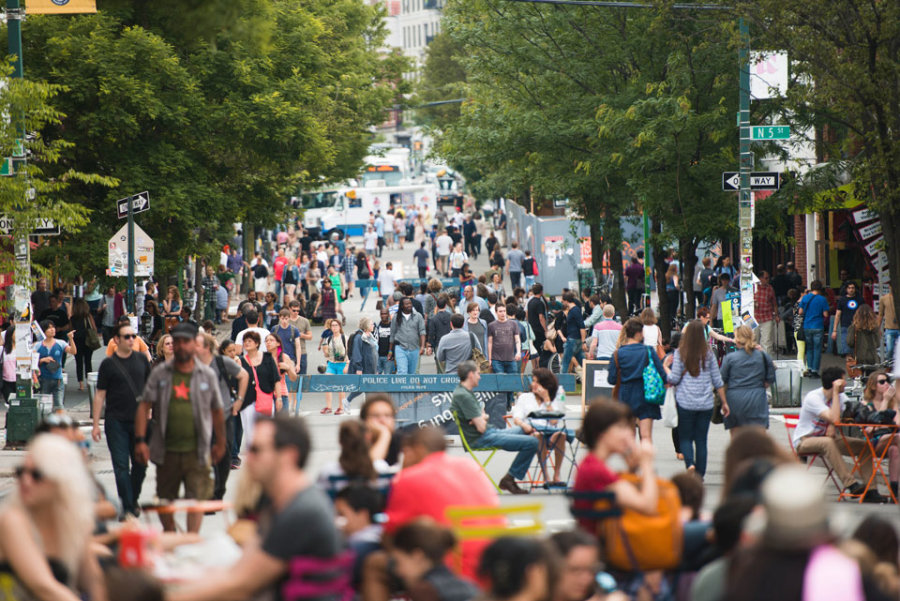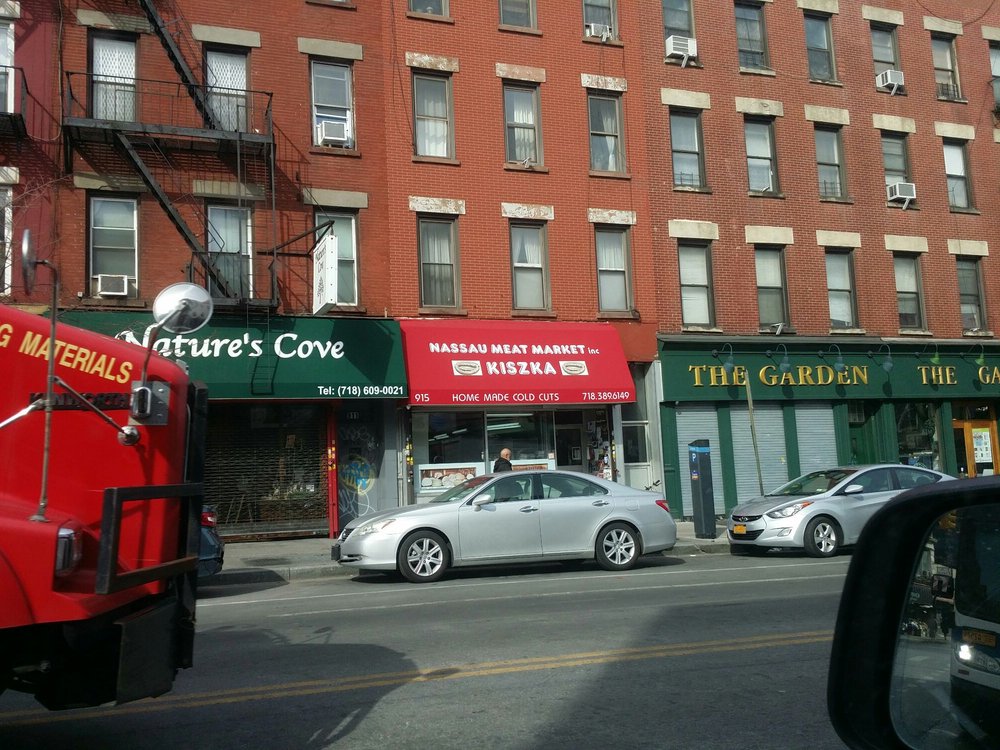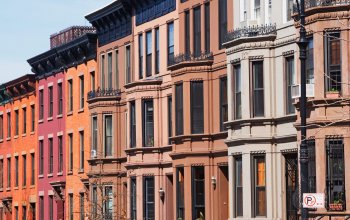The North Brooklyn neighborhoods of Williamsburg, Greenpoint, and Bushwick have a similar vibe and lifestyle. A long standing Hassidic and Dominican neighborhood, Williamsburg’s transformation to arts enclave come hipster HQ began in the late 1980’s/early 1990’s. When artists were priced out of Manhattan’s downtown villages, they sought new digs, preferably with live/work art spaces and easy access to the galleries, theaters, and vibrant creative community they’d left behind.
Enter north Brooklyn. The neighborhood of Williamsburg had everything the artists were looking for, and they moved in. Transforming industrial and factory spaces along Williamsburg’s water front before pressing inland and up along Bedford Avenue and beyond, artists made a new home, and created an essential, burgeoning arts community that would come to rival, if not displace, Manhattan’s dominance in that realm.
After a few decades of artist gentrification of the neighborhood, the prices they’d escaped in Manhattan caught up with new residents looking for a foothold in this vibrant, artsy, hipster-y, spot, that had even more edge than those lovely, somewhat decrepit neighborhoods on the East River’s Manhattan coast. With so many additions to the locality, the area had to expand. Reaching north into Greenpoint, and east into Bushwick, renaming existing areas to match anticipated property values (East Williamsburg, anyone?), real estate pros marketed properties, and intrepid tenants set up housekeeping.
These neighborhoods are represented in the House of Representatives by Nydia Velasquez, who is a fierce advocate for her constituents, and votes democratic pretty much down the line. While these were originally founded by European immigrants, much of that population has been replaced with Latinx residents. There are strong community groups and civic associations, and the neighborhoods are served by the G, L, J, M, Z subway lines, as well as three ferry stops between north and south Williamsburg and Greenpoint piers.
The nightlife, creative life, green space, cuisine, and general wacky New Yorkness cannot be beat. While these neighborhoods can be great for families, they’re even better if you don’t need a babysitter to tell you what time you need to be home. These are great neighborhoods, and they abound with new and old apartment buildings. Check GoHomeNY.com to check out reviews of these buildings before you move in.
Williamsburg
The original. Accept no substitutes. Williamsburg is divided itself into north and south, with the Williamsburg Bridge as the dividing line. South Williamsburg, which maintains a large Hassidic community, is best accessed by the J, M Z subway lines. These lines are notoriously bad, with some New Yorkers claiming that the Z train is actually a myth or urban legend. North Williamsburg, accessible via the L train to Bedford Ave., is what gives Williamsburg its reputation. Cute shoe stores and boutiques, independent bookstores, chill bars and restaurants, galleries and artisanal cheese shops are what Williamsburg is all about. Summer finds artists and crafts people selling their wares at sidewalk tables, and artsy students and 20-somethings showing off their new tats and counter-culture attitudes.

While there has been some cultural conflict between long time communities and new comer interlopers, Williamsburg has a good mix of bodegas, barber shops, and high priced coffee shops. Long time resident decry the new J Crew flagship store, and the trespassing Starbucks on North 7th Street, but the fact remains that Williamsburg has everything required for the ultimate New York lifestyle. When you live in a neighborhood that people like to go to, your commute to fun is as long as it takes to get our your front door.
McCarren Park on the northern edge of Williamsburg proper, is truly a community park. Little League baseball teams and Pee-Wee football squads mix with hung over hipster picnickers partaking in restorative hairs of the dog, photo students doing thesis project fashion shoots, and kids on balance bikes and scooters. On Saturdays a fabulous green market pops up in the park, and the produce and farm fresh meats, eggs, and poultry are well worth braving the crowds.
The new Bushwick Inlet Park on North 9th and Kent Ave features a soccer field, landscaped water front access, and a solar shade structure at the top of a hill that doubles as the roof of a new Parks NYC community and maintenance building, and spectacular views. With two ferry stops, these water edge parks are easy to get to. Summer concerts and performances, along with the original Brooklyn Flea and Smorgasburg, are primary neighborhood attractions. Luxury apartment and condo buildings line the water, but don’t be fooled by the glass and steel. Because of fluctuations in the housing market, rentals in these buildings aren’t as out of reach as their marketing materials make them seem.
In general, you can expect to pay something like $2,000 for a one bedroom, $2,500 for a two-bedroom, and it’s not uncommon for young professionals to have multiple roommates, as well as emerging artists. Though the neighborhood is well populated, and new prospective residents keep coming, there are still deals to be had as many owners are still individual property owners instead of real estate conglomerates or management companies.
Greenpoint
Just off the G line at Greenpoint Avenue, Greenpoint is a long standing Polish community that has mostly welcomed the hipster crowd. Since many long term residents in Greenpoint were property owners instead of renters, it was their own property values that increased when the neighborhood became fashionable. Stretching from Nassau Avenue up to Newtown Creek, Greenpoint has iconic bakeries, like Peter Pan Donuts. Classic Polish butcher shop Kiszka features every conceivable kind of Polish sausage, which turns out to be more than even imaginable. If you’re feeling intrepid, but don’t speak Polish (there are no English signs in the shop), stand behind someone who seems to know what they’re doing, and just duplicate their order. At Easter, lines for ham are out the door, so either arrive early, or prepare to stay late.

While contemporary bars designed for hipster youth abound, there are still plenty of old Polish drinking establishments. Drinking and eating are great New York past times, and in that regard, Greenpoint does not disappoint. Bars here have a little more space than their Williamsburg counterparts, and offer outdoor space for summer barbecues and concerts, as well as endless mimosa brunches and afternoon happy hours where you can expect to find stroller parking out front.
Although Newtown Creek is pretty, with sailboats, canoe trips, and kayak clubs, it is also the location of a Federal Super Fund site. It was declared a Super Fund site in 2010 by the Environmental Protection Agency. According the the New York Times, “water samples from Newtown Creek… have revealed the presence of pesticides, heavy metals, P.S.B.’s, volatile organic compounds, and other contaminants.” It also suffered the impact of countless oil spills during the 19th Century, when it was an industrial center for shipping, factories, and refineries. In fact, the Civil War era ship the USS Monitor, first iron clad steamship, was built on Greenpoint’s shores, hence the name Monitor Street.
Along the water, more green ways are under construction, and eventually, there should be bike trails and green space running the length of the East River corridor along Brooklyn’s coast. This is part of a Parks revitalization that began development under Mayor Michael Bloomburg, and was one of his most important contributions to New York City life. North of Greenpoint Avenue, the street names are in alphabetical order, with Ash and Box Streets all the way to the north, landing at Greenpoint Ave in the south.
Bushwick
While the quality of buildings in Bushwick pales in comparison to the new construction in both Grenepoint and Williamsburg, not to mention the older homes and buildings that have been well maintained, the life style has distinct similarities. Artists occupy live/work spaces and find spaces to create and generate new work. From visual art to performance, Bushwick offers scads of generative artists who live in cheap and cheaper apartments in order to make work out of life, instead of life out of work.
This is a neighborhood that has been less welcoming of gentrification, primarily because most long term residents in Bushwick are renters instead of property owners who experience the benefit of an increase in real estate prices. Bordered by the Queens neighborhood of Ridgewood to the north and Brooklyn’s historically black Bedford-Stuyvesant neighborhood to the south, Bushwick offers quirky eateries staffed with even quirkier artists, musicians, writers, activists, and would-be revolutionaries.
Bushwick boasts great Mexican food options, as well as being home to some of the City’s best inexpensive eats, such as Roberta’s, The Narrows, and Little Skips. A local gem that draws audience from all over the City is the Bushwick Starr. A performance venue that features the latest and greatest in avant-garde and independent theater, the Bushwick Starr is not to be missed. The artists you see at the Bushwick Starr today will be on international stages tomorrow. And when you go, don’t miss the oysters and lobster rolls at Sea Wolf, right off the L train’s Jefferson stop.
Be Heard at Go Home NY
Be heard! Leave your apartment, condo, and coop building reviews at Go Home NY! Know a building's managers are awful? Have the inside line on a perfect building? Anything in between? Express your voice and be heard. Leave a review at Go Home NY.
Be Heard at Go Home NY
Be heard! Leave your apartment, condo, and coop building reviews at Go Home NY! Know a building's managers are awful? Have the inside line on a perfect building? Anything in between? Express your voice and be heard. Leave a review at Go Home NY.


